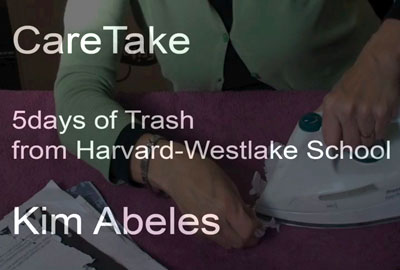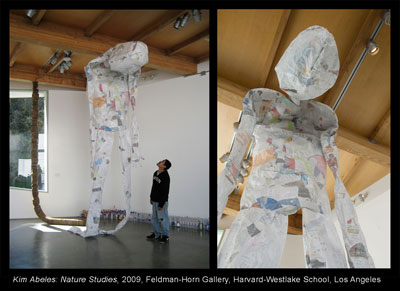Nature Studies
Kim Abeles in collaboration with Harvard-Westlake classes
2009
Each year, the Harvard-Westlake visual arts department hosts a professional artist’s exhibit on its North Hollywood campus. In 2009, inspired by the school's green initiative, Visual Arts Dept. Chair Cheri Gaulke contacted artist Kim Abeles, who has a reputation for exposing environmental issues via her work.
Over a period of five weekdays, Abeles went dumpster diving at Harvard-Westlake’s upper school to collect trash without the general knowledge of students, faculty or staff. She then cleaned, ironed and assembled the trash in her studio and transformed it into new artwork.
Abeles also worked with students and teachers at Harvard-Westlake to create art pieces that demonstrate the effects of human waste and consumption on the environment. Students taking video, photography, math, science and journalism courses all participated in some way to the Nature Studies exhibit.
One of the pieces of artwork created from the dumpster diving is a 30-foot long human-figure-like sculpture made from just one day of paper collected from the trash. Although the school uses a service that sorts recyclables out of its office and classroom trash, Abeles made a point of collecting the garbage before the trash-collectors did. More than one student discovered drafts of homework assignments comprising the sculpture.
Some of the projects resulting from the dumpster diving were not originally planned. After hauling just a few extremely heavy bags of trash from the dumpsters to her car, Abeles opened up a few, and noticed numerous partially filled water bottles. She started to dump the water -- until a (compact fluorescent) light bulb came on in her head ...
Abeles enlisted the help of Advanced Placement Environmental Science Teacher Tara Kheradyar, who determined that even non-classroom activities should include some "green" work. Kheradyar had students she was monitoring for detention measure and calculate the average amount of un-drunk water thrown out with each bottle. The end result, determined by evaluating five days of water bottles thrown out at school, was that, on average, each water bottle thrown away still contained 40 percent of its original water.
- Excerpt from a March 4, 2009 press release from Harvard-Westlake School, Los Angeles

view the video
| slow connection |

